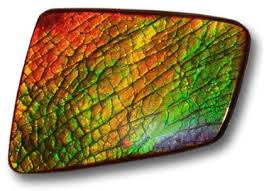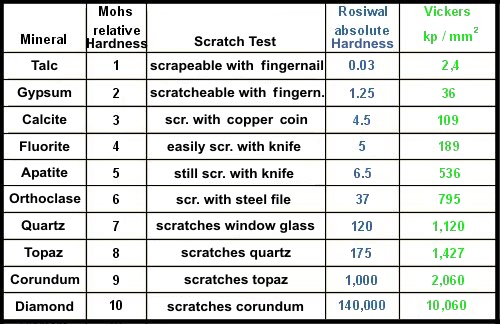Ammolite
A kaleidoscope of iridescent colours displayed on the outside of a fossil and from just one small location on the planet - now that’s rare!
 |
| Unprocessed Ammolite |
Ammolite is claimed by many to be the rarest gemstone on the planet. Whilst this might be taking it a little far, it is certainly incredibly rare and to-date has only ever been discovered in the isolated region of Southern Alberta, Canada.If you were to ask me to categorise its rarity, I would put it on a par with Zultanite and Paraiba Tourmaline. The problem with Ammolite doesn’t stop with its rarity and just like Zultanite, taking the rough material and converting it into a piece that can be set into jewellery is ...
... a real lapidarist’s challenge.
Whilst with Zultanite the difficulty is due to its crystal structure having perfect cleavage, Ammolite is very delicate and only forms in wafer thin microscopic layers. Whilst we are talking about the similarities with Zultanite, there is one more! Both gemstones are two of the last gemstones to be credited with an official gemstone status. But before we go into this in more detail, let me explain exactly how this incredibly iridescent gemstone was formed.
 |
Ammonite fossil showing the
Ammolite iridescence |
You may remember studying Ammonites at school; these are one of the most instantly recognised forms of fossils to be found on the planet. Ammonites looked something similar to a squid and their habitat was warm tropical waters. Along with dinosaurs, they became extinct around 65 million years ago at the end of the Mesozoic Era. The gemstone Ammolite is found on the upper shell of the Ammonite fossil, but only on those found in Southern Alberta. This sort of explains its rarity: here is a gemstone that can only be found attached to a fossil and only on a particular type of fossil that came to rest in just one location. According to local miners, even once they find an Ammonite in the region, only 5% demonstrate any iridescence and of these, only a tiny percentage are of gem quality!
 |
| Western Interior Seaway |
Back in the Mesozoic Era there was a warm tropical sea area known today as the Western Interior Seaway. Due to the movement of tectonic plates this no longer exists and the area is now some 500 miles from the Canadian coastline. As the sea receded and turned to land the Ammonites became buried in a layer of sediment containing the mineral Bentonite. It was the presence of this mineral in this one location that preserved the wonderful iridescence of the shell and which prevented it from becoming a normal calcite fossil.
 |
| Magrath, Alberta, Canada |
The gem is found near the extremely remote town of Magrath, in an area located near the Red Deer River and the St Mary’s River in southern Alberta (the nearest major city is Lethbridge). According to folklore the gem was first discovered by a lady who was part of a Blackfoot Indian Tribe. During a very harsh winter, all of the buffalo disappeared and whilst searching for firewood in deep snow, she came across the gemstone under a cottonwood tree. As she held the gem a spirit contacted her and told her it would act as a powerful talisman and would bring the buffalo back to the tribe.
 |
| Blackfoot hunting Buffalo |
Sure enough, the very next day, buffalos were seen near the tribe’s camp. Even today, members of the Blackfoot Tribe wrap the gemstone in buffalo hide and use the gem in ritual ceremonies before they go hunting.
So it’s incredibly rare, has a great history, but what’s it physically like? Well, I mentioned at the very beginning that the layer of Ammolite is incredibly thin. It is also very soft measuring just 4.5 to 5.5 on the Mohs scale.
It’s also very brittle and very flaky, and will also bleach if exposed to sunlight for long periods. Not the sort of information you want to hear if you’re a miner and have just uncovered a piece in the earth! Here is a gemstone that has the appearance of the Northern Lights crossed with a Boulder Opal, it has beautiful patterns like spiders webs and is visually one of the prettiest natural items on the planet, but it’s not going to last. Luckily this is the age of modern technology, where we have the ability to preserve real treasures. By delicately removing the thin layer from the Ammonite and re-bonding it to a pre-cut slice of the original fossil and then by topping the gem in transparent natural Quartz, the gem becomes preserved.
 |
| Processed Ammolite |
The Quartz on the top of this triplet is sometimes cut with either parallel bars or checkerboard facets. The interaction of the surface lustre of these facets with the colour play of the gemstone beneath can result in some of the most mesmerising optical effects that you will ever see in a gemstone.
Because the gemstone is normally sold as a triplet, it is not sold by carat weight as this would be very misleading, instead it is valued by its size and its play of colour. The more vibrant the colours and the more kaleidoscopic it is, the more expensive it becomes. Just like Tanzanite and Diamonds have a fairly recognised grading system, so do Ammolites. The very finest Ammolite is graded AA and there are three other grades of A+, A and A-.
 AA
AA Reserved for the only the best stones, which display intense brilliant multidirectional fire with an even spread of at least three vivid colors.
 A+
A+ Bright vivid color which may contain minor inclusions. Three colors with a less even spread, or two very distinct and vivid colors with little or no directional extinction.
 A
A Strong fire of two or more colors (usually red, green), clean and vibrant. Shows color from many angles.
 A-
A- Good color, less vivid and/or bright (typically reddish orange and green). Also referred to as standard grade.
 B
B Colors are faint or less distinct. Less play of color and more directional extinction (colors may fade or disappear as the stone is rotated)
For further info, see this short article by Tom Dryden at the
Gemsociety ammolite page
 |
| Multi-coloured "fingerprint" |
Some Ammolites will show just one colour and these tend to be graded either A or A-. For every different colour you see in an Ammolite, you are actually seeing into the gemstone and looking at different layers. Colour derived by iridescence as is the case with Ammolite, is different to the colour of most gemstones where the colour seen is the result of absorption of light. With Ammolite each colour is actually being returned to the eye by the reflection of different layers. The more layers there are, the more colours you will see. When you see reds and greens you are looking at light bouncing back from thicker layers in the structure, whilst the thinner layers deliver mainly blues and violets. Because these layers are never clearly defined, every single Ammolite will look different, each one with its own multi-coloured fingerprint of nature.
 |
| Multi-coloured "fingerprint"
|
Just like Tanzanite, Zultanite and Larimar, Ammolite is only found in one location on the planet. Similar to claims by the biggest mining organizations in all of these single location discoveries, is that Ammolite will run out in the near future. The biggest mining company Korite International go as far as to claim that Ammolite will run out in 20 years time: now that sounds kind of familiar!
 |
| Multi-coloured "fingerprint" |
Did you know?
Amorphous Gemstones such as Amber, Pearl, Coral, Opals and any others that do not have a crystal structure are referred to as amorphous.
 AA Reserved for the only the best stones, which display intense brilliant multidirectional fire with an even spread of at least three vivid colors.
AA Reserved for the only the best stones, which display intense brilliant multidirectional fire with an even spread of at least three vivid colors.







No comments:
Post a Comment
COMMENTS:
Please keep them clean - imagine someone's mum might be reading this.
And don't be nasty - if you are in a bad mood - do something nice for yourself or somebody else - Thanks.